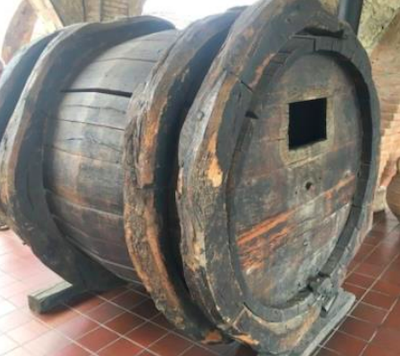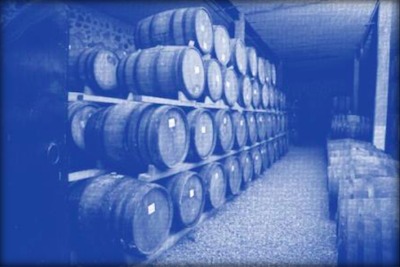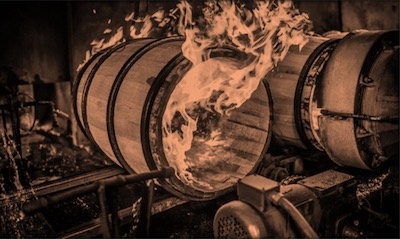CLOSED EASTER SUNDAY // HOURS: TUESDAY-SATURDAY 12-6PM, SUNDAY 11-5PM
Vol. 20 - "Oaky Wine"
In this latest volume of Zero-Two-Wine-Three-Eight, aka The Most Opinionated Wine Newsletter in America, Bertil tackles the topic of oak..
Click here for the full experience: the original pdf-formatted version of this article.
Wine & Cask
Good and Evil
What should we say, oakiness or woodiness?
Book of Bertil 20.01
"Then the serpent said to the woman, 'You shall not die; but God knows that in the day you eat of it, your eyes will be opened, and you will be like gods, knowing good and evil." (Genesis 3:4-5)"
CHAPTER 1.0
Neutral Preamble
Like our American policy today, there is no longer moderation of opinion, just extremes. So, it is the same in our choice of wine, we must be absolutely Pro-Oak or Anti-Oak, nothing else. Yet wood is wine's best friend. They are often too perfect a couple; but unfortunately, unknown and misunderstood. I’m offering you a chance to dive into the adventure of the barrel, of the Gaul’s to our days, via its history, its evolution, and its deviations.
In the second part, I will explain how to understand better what a woody wine is, in order to describe whether it’s good or evil, and the importance of its carnal sin with oak. We hope that through this reading you will be able to form a more objective and less radical opinion of it. Because moderation always tastes better.

20.1.1 The short history of the wooden barrel,
Because everything is always a story of proximity
At the origin of wine, and especially among the Greeks and Romans, wine was transported in amphorae of refined clay, and the reason was simple. Infinite availability of quality clay, and a warm climate allowed for year-round drying and baking. In the north, the Celts, then the Gaul’s (the north of current France), who were living in a less arid and humid climate, allowed a profusion of forests of various tree species, and often of a maturity of 100-200 years of age. They would therefore use wood for the manufacture of their containers and develop the technique of hot wood bending in the manufacture of circular barrels. These barrels were originally used to store and preserve Cervoise (Gallic beer) and various foodstuffs. The Gaul’s very quickly learned to choose the right varieties of trees according to the utilitarian need to which they will be assigned them. It was not until the time of the Gallic Wars by the Roman armies (50's BC) that the barrel technique was used for transport, and the preservation of wine by the Roman inquisitors.

20.1.2 The explosion of the barrel from the XVII century to the present day.
With the expansion of colonization and the discovery of new continents, the need for consumer products such as wine and brandies multiplied. These trades, which are becoming more and more numerous between countries and continents, make the barrel become essential to the wine trade. Because a large quantity of wine will be sent to northern Europe, to India, and to the American continent, the duration of the transports was often so long that the wine remained in contact with the wood often for months. The merchants then fully realized what the barrel brought in woody aromas and refinement on the wines transported, and this in comparison with the new wines that were often sold and consumed only a few months after their vinification ends.
This is the birth of the Oenological barrel.

The barrel has not changed shape and manufacture for 2000 years. Its greatest production is until the beginning of the 20th century for the manufacture of large volume containers, and preferably from neutral wood species. They are the first wine vats, called "La foudre." Often able to hold over 2000 gallons, they are made of oak, chestnut, acacia, or poplar. As for the wine barrel, it is found from all volumes from 5 liters to 600 liters. The classic barrels are more or less chubby and are also of different volumes according to their regions and their countries of origin. The most common are, the Burgundian barrel of 228 liters, and the Bordeaux barrel of 225 liters (which is narrower and longer than its Burgundian counterpart). Surprisingly the wine barrel saw its decline begin with the phylloxera crisis at the end of the 19th century, and then with the discovery that the wooden barrel could be harmful to wine, if it was poorly manufactured, misused, or housed wine for too long, it was representing a financial risk for its trade. In addition, wood is a plant that grows in a specific soil and climate, with a unique venous and chemical composition. In the same forest depending on the source of the pollination of the initial seed, the tree will have different chemical properties from its neighbor, which will impact on the chemical recompositing of the wine in contact with it. This means that each barrel will produce a different wine, and therefore will require a methodical blending of the entire production before its marketing.

The discovery at the beginning of the 20th century of compounds for the manufacture of neutral containers and large formats, such as concrete (cement) then stainless steel, and PVC, will bring practical and economical solutions to winegrowers. The barrel, and especially the oak barrel will be used only to produce fine and exceptional wines. The barrel no longer travels, it has become sedentary, Oenological.

20.1.3 What is a Woody wine?
Many quality wines are in contact with oak, without developing an oak aroma. In wines, oak, or other wood such as acacia, is expressed by derived aromas. The aroma of freshly sawn oak is not present as such because winemakers generally prefer more flattering aromatic notes. So, only new wood communicates aroma and used wood is more neutral. A barrel is considered neutral (exhaustion of wood tannins) from the third year of use. These aromas depend on the origin of the wood, European or American, and the heating (toast) used by the cooper. Heating is a complex art where the contact time with fire, temperature and method varies. There will never be two barrels exactly the same, even if they come from the same tree and the same cooper. The intensity of the heating destroys some aromas and creates others, a bit like bread that changes taste when toasted, depending on the setting of the toaster, from light to burned. The "toast" heating is necessary in the manufacture of a barrel because this step is essential in order to bend and seal the barrel. Wood in general requires only light heating (if the wood is of quality), and therefore for white wines the winegrowers will generally move towards moderate heating, to avoid masking the delicate aromas of the wine. As for red wines, they will withstand more marked heats, going as far as smoky or toasted bread aromas, black licorice, and much more.

21.21 Woodiness VS Oakiness
The end of the 20th century
You regularly drink, without realizing it, white, rosé, orange, or red wines which have been in contact with wood. Because the barrel is the ideal container for the refinement of wines which requires a micro-oxidation contribution during its ageing. Its subtlety will bring to your wine, aromas of vanilla, coconut (American oak), undergrowth, completed with fine woody notes such as sandalwood, and finally spicy or vegetal cloves (woody). If the barrel used is new, it will release in the wine a large amount of tannins (which will decrease in quantity in the first three years). This is what is called, a “woody” wine.
But then what is Oakiness?
Oakiness are the vegetable aromas from the Oak. These are the aromatic and chemical combinations of the different factors related to tannins. When they are combined with red wines, they blend into the structure of the wine and are noticeable by the presence (largely) of powerful and firm tannins. This sensation is not olfactory (aromas), but tactile (taste).
The fermentation of red wines is not done in barrels, but in neutral open vats (fermenters). Only the education and refinement of the wine is done after fermentation in the barrel. For the great fine red wines, the malolactic fermentation (MLF) will be done in barrels. For white wines, primary and malolactic fermentation can take place in barrels if the wine has been previously separated from its skins and a large part of the pulp. In both cases the excess, the origin of the wood (European oak or American oak) can develop tastes that can by some seem too hot and too powerful.

21.2.2 Can a wine that is too oaky be a defect?
A question to ask Robert Parker!
It's mostly a matter of taste! If you taste it in its youth a powerful red or white wine intended for a long aging in the cellar, you may find it excessively woody: this is normal because the winemaker anticipated the evolution of bottled wine and dosed the wood for optimal tasting after a decade or more! But on young wines made to be consumed quickly, these choices are then wanted by the winemaker, and this to meet a particular profile of consumers. They are usually powerful wines, with high alcohol and residual sugar levels, lots of body, and a feeling of firm and tense tannins. In white wines, excessive aromas brought by the combination of new wood, over-burned toasting by grapes from climates too hot for their typicity. But also, many other chemical molecular reactions (natural) are also to be taken into consideration.

21.2.3 So, in a white wine, how can I express Oakiness?
What you define as "to Oaky" are excessive aromas, but above all a physical volume of the wine in your mouth very exacerbated "the Oaky taste". It is this extreme sensation that is for some pleasant and for others not so great. It is a set of tastes including coconut, hot butter, custard, over-grilled toast, synthetic vanilla extract, extravagant bouquet of white flowers, beeswax and honey, perfume of makeup powder, floral, and musk. In the mouth the wine is hot by alcohol, round and fatty as if you had crunched in a piece of butter at the same time as eating a butterscotch candy.

Conclusion
The good of the "Parkerization" effect
Robert Parker is an American wine critic (now retired) who influenced the entire wine world from the late 70s. As the saying goes: "Tell me what you drink, I'll tell you where you come from". His taste for powerful wines, very woody, warm, and high in alcohol demonstrates the origin of his very "American Californian" pallet (He was born in Maryland). Its influence was so great that winemakers from all countries and wine regions began to modify in the 90s the typicity of their wines to produce so-called "Parkerized" wines. We can say that its taste and influence has contributed to the standardization of wine taste throughout the world. If this has been a great evil for the industry and consumers, the Parker syndrome, like a return of the pendulum, has created a new demand on the part of consumers for wines, less powerful, less heavy, less sweet, less alcoholic. It is therefore the reason for the current movement of the revival of "Authors'" wines, terroir wines, true wines.
So, thank you Mr. Parker, because by this “evil” you have allowed us to appreciate again the good, the moderation, the open dialogue, as respecting that one wine can be different from another, and that all tastes can be expressed and appreciated for what they are and what they will never be, monolithic.
Mr. B
*Memorandum: My words and opinions in these newsletters are and would always be personal, and I intend to offend. I always accept that others have the full right and duty to challenge me, to argue, and, if it is necessary, excommunicate me from their beliefs (often dull and hollow) because I would act the same way if it were the other way around.
Display prices in:USD

